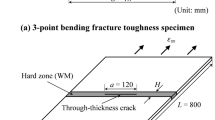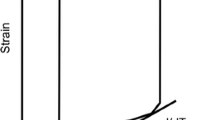Abstract
This paper proposes an estimation method for crack tip opening displacement (CTOD) in laser welds. The theoretical model for CTOD estimation developed by Dugdale and Bilby et al. (DBCS model) was used for laser-welded plates. The yield stress of the laser weld metal and narrow hard zone width affected the CTOD, and the correction of yield stress by using the DBCS model to obtain a suitable CTOD estimation was investigated. To apply the DBCS model to CTOD estimation for laser welds, an equivalent yield stress concept was proposed. The equivalent yield stress was affected by the strength mismatch ratio and hard zone width, because the yield stress of the laser weld metal decreases with the constraint loss caused by the plastic deformation that occurred in the base metal. The predicted CTOD from the value of applied load obtained using the proposed estimation method agrees well with experimental critical CTODs for laser welds of both 780 and 520 MPa class structural steel.


















Similar content being viewed by others
References
Kristensen JK (2009) Thick plate CO2-laser based hybrid welding of structural steels. Weld World 53:48–57. https://doi.org/10.1007/BF03266691
Hesse AC, Nitschke-Pagel T, Dilger K (2019) Investigations on the impact and fracture toughness of beam welded structural steels with yield strengths from 355 to 960 MPa. Weld World 63:87–95. https://doi.org/10.1007/s40194-018-0635-1
Nagel M, Langenberg P, Lüder F et al (2002) Discussion of testing procedures for the determination of the toughness properties of laser welded joints. Eur Struct Integr Soc 30:253–261
Inose K, Yamaoka H, Nakanishi Y, Minami F (2017) Toughness assessments of laser arc-hybrid welds of ultra high strength steel. Weld World 57:1–7. https://doi.org/10.1007/s40194-017-0483-4
Inose K, Kanbayashi J, Abe D et al (2013) Design and welding method for high-strength steel structure using laser-arc hybrid welding. Weld World 57:657–664
Bayraktar E, Hugele D, Jansen JP et al (2004) Evaluation of pipeline laser girth weld properties by Charpy(V) toughness and impact tensile tests. J Mater Process Technol 147:152–162
Takashima Y, Ohata M, Minami F (2009) Fracture toughness evaluation of laser beam-welded joints of 780 MPa-strength class steel. Weld World 53:R304–R311. https://doi.org/10.1007/BF03263473
Takashima Y, Nishi T, Shoji H, Ohata M, Minami F (2014) Evaluation method for Charpy impact toughness of laser welds based on lateral contraction analysis. Weld World 58:289–295. https://doi.org/10.1007/s40194-014-0114-2
Takashima Y, Ohata M, Inose K, Yamaoka H, Nakanishi Y, Minami F (2016) Evaluation of Charpy impact toughness using side-grooved specimen for hybrid laser-arc welds of ultra-high-strength steel. Weld World 60:1191–1199. https://doi.org/10.1007/s40194-016-0383-z
Minami F, Takashima Y, Ohata M et al (2018) Fracture assessment procedure developed in Japan for steel structures under seismic conditions. Eng Fract Mech 187:142–164. https://doi.org/10.1016/j.engfracmech.2017.10.034
Spurrier J, Hancock P, Chubb JP (1996) An assessment of weld mis-matching. Eng Fract Mech 53:581–592. https://doi.org/10.1016/0013-7944(95)00180-8
Schwalbe KH (1992) Effect of weld metal mismatch on toughness requirements - some simple analytical considerations using the engineering treatment model (ETM). Int J Fract 56:257–277. https://doi.org/10.1007/BF00012330
Schwalbe KH (1993) Welded joints with non-matching weld metal-crack driving force considerations on the basis of the engineering treatment model (ETM). Int J Fract 62:1–24. https://doi.org/10.1007/BF00032522
Zerbst U, Ainsworth RA, Beier HT et al (2014) Review on fracture and crack propagation in weldments – a fracture mechanics perspective. Eng Fract Mech 132:200–276. https://doi.org/10.1016/j.engfracmech.2014.05.012
Satoh K, Toyoda M, Minami F et al (1985) Effect of mechanical heterogeneity on fracture toughness evaluation of steel welds. Trans Japan Weld Soc 16:170–177
Lin G, Meng XG, Cornec A, Schwalbe KH (1999) The effect of strength mis-match on mechanical performance of weld joints. Int J Fract 96:37–54. https://doi.org/10.1023/A:1018692718678
Minami F, Takashima Y, Ohata M (2011) Constraint-based assessment of CTOD toughness requirement for high-strain line pipe. Int J Offshore Polar Eng 21:129–140
Bilby BA, Cottrell AH, Smith E, Swinden KH (1964) Plastic yielding from sharp notches. Proc R Soc Lond 279:1–9
Harrison JD (1980) The state-of-the-art in crack tip opening displacement (CTOD) testing and analysis - part 1: background and testing methods. Metal Construct 12:415–422
Minami F, Ohata M, Tanizawa A et al (2007) Significance of fracture toughness of laser welds for structural steels and fracture performance assessment by Weibull stress criterion – improvement of steel structural performance by laser beam welding for mid-thick section steel plate. Quart J Jpn Weld Soc 25:149–158 (in Japanese)
Takashima Y, Ohata M, Minami F (2009) Fracture performance evaluation of laser beam welded joints based on the Weibull stress criterion. In: American Society of Mechanical Engineers, Pressure Vessels and Piping Division (Publication) PVP. ASME, pp 551–556
Funding
This work was supported by JSPS KAKENHI Grant Number JP19K05030 and financially supported by Project to Create Research and Educational Hubs for Innovative Manufacturing in Asia, Osaka University of Special Budget Project of the Ministry of Education, Culture, Sports, Science and Technology.
Author information
Authors and Affiliations
Corresponding author
Additional information
Publisher’s note
Springer Nature remains neutral with regard to jurisdictional claims in published maps and institutional affiliations.
Recommended for publication by Commission X - Structural Performances of Welded Joints - Fracture Avoidance
Rights and permissions
About this article
Cite this article
Takashima, Y., Shao, C., Lu, F. et al. Numerical investigation of CTOD estimation methods for laser welds. Weld World 64, 1185–1193 (2020). https://doi.org/10.1007/s40194-020-00904-4
Received:
Accepted:
Published:
Issue Date:
DOI: https://doi.org/10.1007/s40194-020-00904-4




